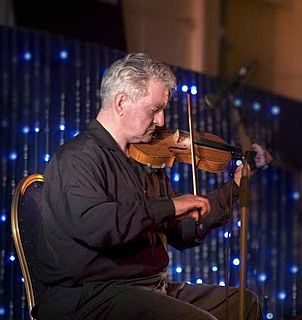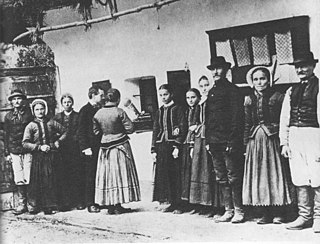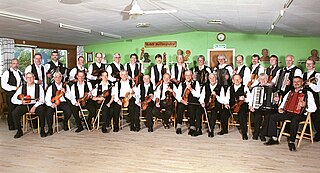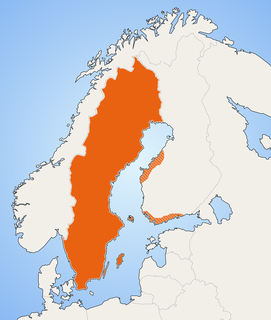
The Donegal fiddle tradition is the way of playing the fiddle that is traditional in County Donegal, Ireland. It is one of the distinct fiddle traditions within Irish traditional music.

Fiddling refers to the act of playing the fiddle, and fiddlers are musicians that play it. A fiddle is a bowed string musical instrument, most often a violin. It is a colloquial term for the violin, used by players in all genres including classical music. Although violins and fiddles are essentially synonymous, the style of the music played may determine specific construction differences between fiddles and classical violins. For example, fiddles may optionally be set up with a bridge with a flatter arch to reduce the range of bow-arm motion needed for techniques such as the double shuffle, a form of bariolage involving rapid alternation between pairs of adjacent strings. To produce a "brighter" tone, compared to the deeper tones of gut or synthetic core strings, fiddlers often use steel strings. The fiddle is part of many traditional (folk) styles, which are typically aural traditions—taught 'by ear' rather than via written music.

Folk music includes traditional folk music and the genre that evolved from it during the 20th-century folk revival. Some types of folk music may be called world music. Traditional folk music has been defined in several ways: as music transmitted orally, music with unknown composers, or music performed by custom over a long period of time. It has been contrasted with commercial and classical styles. The term originated in the 19th century, but folk music extends beyond that.

The reel is a folk dance type as well as the accompanying dance tune type. Of Scottish origin, reels are also an important part of the repertoire of the fiddle traditions of the British Isles and North America. In Scottish country dancing, the reel is one of the four traditional dances, the others being the jig, the strathspey and the waltz, and is also the name of a dance figure.
The polska is a family of music and dance forms shared by the Nordic countries: called polsk in Denmark, polska in Sweden and Finland, and by several different names in Norway. Norwegian variants include pols, rundom, springleik, and springar. The polska is almost always seen as a partner dance in 3
4-beat (help·info), although variants in 2
4 time, as well as in compound meters also exist.

The Music of Sweden shares the tradition of Nordic folk dance music with its neighboring countries in northern Europe, including polka, schottische, waltz, polska and mazurka. The accordion, clarinet, fiddle and nyckelharpa are among the most common Swedish folk instruments. The instrumental genre is the biggest one in Swedish traditional music. In the 1960s, Swedish youth sparked a roots revival in Swedish folk culture. Many joined Spelmanslag and performed on mainstream radio and TV. They focused on instrumental polska music, with vocals and influences from other traditional genres becoming more prominent since the 1990s. By 1970, the "dansband" culture also began.
Cajun music, an emblematic music of Louisiana played by the Cajuns, is rooted in the ballads of the French-speaking Acadians of Canada. Cajun music is often mentioned in tandem with the Creole-based zydeco music, both of Acadiana origin, and both of which have influenced the other in many ways. These French Louisiana sounds have influenced American popular music for many decades, especially country music, and have influenced pop culture through mass media, such as television commercials.

Eivind Groven was a Norwegian microtonal composer and music-theorist. He was from traditional region of Vest-Telemark and had a background in the folk music of the area

A Hardanger fiddle is a traditional stringed instrument used originally to play the music of Norway. In modern designs, this type of fiddle is very similar to the violin, though with eight or nine strings and thinner wood. Four of the strings are strung and played like a violin, while the rest, aptly named understrings or sympathetic strings, resonate under the influence of the other four.
Old-time music is a genre of North American folk music. It developed along with various North American folk dances, such as square dancing, clogging, and buck dancing. It is played on acoustic instruments, generally centering on a combination of fiddle and plucked string instruments, as well as the mandolin.
Here Northumbria is taken to mean Northumberland, the northernmost county of England, and County Durham, as is defined by the Oxford English Dictionary. This area, together with Tweeddale, was the ancient British tribal kingdom of Bernicia (Bryneich) and is notable for the stable ancestry of its present indigenous population, which has been identified by DNA analysis to be an offshoot of the group Scotland, Cumbria and the North of Ireland, but not so closely related to the other peoples of the UK. The area was the core of the outstanding artistic culture that developed during the Northumbrian Golden Age of the 7th and 8th centuries; it would be unwise to suggest that the area did not have a flourishing musical culture at that time, or that it was not of similar sophistication - Bede makes reference to the playing of the harp.

Austrian folk dancing is mostly associated with Schuhplattler, Ländler, Polka
or Waltz. However, there are other dances such as Zwiefacher, Kontratänze and Sprachinseltänze.
Traditional Nordic dance music is a type of traditional music or folk music that once was common in the mainland part of the Nordic countries — Scandinavia plus Finland. The person who plays this kind of music might be called speleman (Swedish/Norwegian), spelman (Swedish), spel(l)emann (Norwegian), pelimanni (Finnish) or spillemand (Danish). Finnish traditional dance music is often called pelimanni music in English, while there does not seem to exist a similar, widespread term for the corresponding music from the other countries. It is often more meaningful to distinguish between the traditional dance music from different regions than between music from the countries as such. Some concepts in the field can be defined as Norwegian or Finnish, but most are either common to all four countries or local. Besides the dance music tradition, all countries also have other traditions of folk music that are not shared to a similar extent.
The hambo is a traditional dance that originated in Sweden in the late 19th and early 20th centuries. It is a couple dance in 3
4 time, danced to music played with a strong accent on the first beat and a tempo that varies from moderate to fast. The hambo is a dance with a fixed pattern and tunes almost always have a corresponding eight measure structure.

Irish traditional music is a genre of folk music that developed in Ireland.

A spelman is a player of Swedish folk music. The term has also the same meaning for Norwegian folk music, and corresponds directly to the term spillemand in Danish traditional music. Less often spelman may be folk musicians from other Nordic countries, from other European countries, from non-European countries, and even musicians in other genres. The meaning of the Swedish word spelman is very similar to that of the English "fiddler," except that it is not tied to a specific instrument. Because of the commonality of the fiddle in Swedish folk music, the word is often translated as fiddler in any case. Technically, the actual Swedish word for fiddler would be "fiolspelman".

The Icelandic fiddle is a traditional Icelandic instrument that can be described as a box with two brass strings which is played with a bow. The strings stretch across one end of the box to the other where they are tuned by two tuning pegs.

Danish traditional music is the music genre that has its roots in pre-modern Denmark. In this period it was common for towns to have one or more town musicians who played at dances, processions and certain rituals. In the 17th and 18th centuries, professional music performances were monopolized by town musicians, who also traveled into the neighboring rural areas to perform. Urban music and dance styles, often from other parts of Europe, penetrated the countryside and almost eradicated earlier styles. This period also saw the introduction of the fiddle as the most important instrument and the abandonment of earlier chain dances in favor of pair dances. Until around 1900, traditional music was the common musical culture of Denmark, but with increasing urbanization and the spread of classical music it became marginalized to rural areas.
The Chapelloise is a traditional folk dance with change of partners, belonging to the standard repertoire of a Bal Folk. Its most common name in France and the French-influenced European Bal Folk scene is Chapelloise, but the dance has many other names too.














